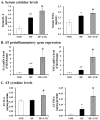Vitamin D Insufficiency Exacerbates Adipose Tissue Macrophage Infiltration and Decreases AMPK/SIRT1 Activity in Obese Rats
- PMID: 28353634
- PMCID: PMC5409677
- DOI: 10.3390/nu9040338
Vitamin D Insufficiency Exacerbates Adipose Tissue Macrophage Infiltration and Decreases AMPK/SIRT1 Activity in Obese Rats
Abstract
Obesity is recognized as a state of chronic low-grade systemic inflammation due to adipose tissue macrophage infiltration and production of proinflammatory adipokines. Decreased vitamin D status is associated with obesity. The specific aim of the present study is to investigate the effects of vitamin D on obesity-induced adipose tissue inflammation. Male Sprague-Dawley rats were randomized and fed a normal diet (NOR, 1000 IU vitamin D/kg diet), a 45% high-fat diet (HF, 1000 IU vitamin D/kg diet), or a 45% high-fat diet containing 25 IU vitamin D/kg diet (HF+LVD) for 12 weeks. The vitamin D-insufficient diet (HF+LVD) led to vitamin D inadequacy as determined by serum 25(OH)D level, 68.56 ± 7.97 nmol/L. The HF+LVD group exacerbated HF-increased adipocyte size, adipogenic gene expression of PPARγ, adipose tissue macrophage recruitment, and proinflammatory cytokine IL-6 and TNFα levels in epididymal white adipose tissue. In addition, vitamin D insufficiency significantly decreased mRNA levels of β-oxidation-related genes such as CPT1α, PGC1α, PPARα, VLCAD, LCAD, MCAD, and UCP1. Moreover, significant decrements of SIRT1 and AMPK activity were noted in obese rats fed with a vitamin D-insufficient diet. The observed deleterious effects of vitamin D insufficiency on adipose tissue expansion, immune cell infiltration and inflammatory status suggest vitamin D plays a beneficial role in adipocyte metabolic metabolism and obesity progression. SIRT1 and AMPK activity may play a role in the mechanism of vitamin D action.
Keywords: adenosine monophosphate-activated protein kinase (AMPK); adipose tissue macrophage infiltration; obesity; sirtulin 1 (SIRT1); vitamin D.
Conflict of interest statement
The authors declare no conflict of interest.
Figures





Similar articles
-
Effects of Vitamin D Supplementation on Adipose Tissue Inflammation and NF-κB/AMPK Activation in Obese Mice Fed a High-Fat Diet.Int J Mol Sci. 2022 Sep 18;23(18):10915. doi: 10.3390/ijms231810915. Int J Mol Sci. 2022. PMID: 36142842 Free PMC article.
-
Chrysanthemum morifolium Flower Extract Ameliorates Obesity-Induced Inflammation and Increases the Muscle Mitochondria Content and AMPK/SIRT1 Activities in Obese Rats.Nutrients. 2021 Oct 19;13(10):3660. doi: 10.3390/nu13103660. Nutrients. 2021. PMID: 34684660 Free PMC article.
-
Tartary Buckwheat Extract Attenuated the Obesity-Induced Inflammation and Increased Muscle PGC-1a/SIRT1 Expression in High Fat Diet-Induced Obese Rats.Nutrients. 2019 Mar 18;11(3):654. doi: 10.3390/nu11030654. Nutrients. 2019. PMID: 30889894 Free PMC article.
-
Vitamin D signalling in adipose tissue.Br J Nutr. 2012 Dec 14;108(11):1915-23. doi: 10.1017/S0007114512003285. Epub 2012 Oct 9. Br J Nutr. 2012. PMID: 23046765 Review.
-
Macrophage recruitment in obese adipose tissue.Obes Rev. 2015 Feb;16(2):127-36. doi: 10.1111/obr.12242. Epub 2015 Jan 13. Obes Rev. 2015. PMID: 25586506 Free PMC article. Review.
Cited by
-
Chronic calcitriol supplementation improves the inflammatory profiles of circulating monocytes and the associated intestinal/adipose tissue alteration in a diet-induced steatohepatitis rat model.PLoS One. 2018 Apr 23;13(4):e0194867. doi: 10.1371/journal.pone.0194867. eCollection 2018. PLoS One. 2018. PMID: 29684027 Free PMC article.
-
Effects of Vitamin D Supplementation on Adipose Tissue Inflammation and NF-κB/AMPK Activation in Obese Mice Fed a High-Fat Diet.Int J Mol Sci. 2022 Sep 18;23(18):10915. doi: 10.3390/ijms231810915. Int J Mol Sci. 2022. PMID: 36142842 Free PMC article.
-
The Molecular Mechanisms by Which Vitamin D Prevents Insulin Resistance and Associated Disorders.Int J Mol Sci. 2020 Sep 11;21(18):6644. doi: 10.3390/ijms21186644. Int J Mol Sci. 2020. PMID: 32932777 Free PMC article. Review.
-
Molecular Aspects in the Development of Type 2 Diabetes and Possible Preventive and Complementary Therapies.Int J Mol Sci. 2024 Aug 22;25(16):9113. doi: 10.3390/ijms25169113. Int J Mol Sci. 2024. PMID: 39201799 Free PMC article. Review.
-
Vitamin D Insufficiency in Overweight and Obese Children and Adolescents.Front Endocrinol (Lausanne). 2019 Mar 1;10:103. doi: 10.3389/fendo.2019.00103. eCollection 2019. Front Endocrinol (Lausanne). 2019. PMID: 30881343 Free PMC article. Review.
References
-
- Xu H., Barnes G.T., Yang Q., Tan G., Yang D., Chou C.J., Sole J., Nichols A., Ross J.S., Tartaglia L.A., et al. Chronic inflammation in fat plays a crucial role in the development of obesity-related insulin resistance. J. Clin. Investig. 2003;112:1821–1830. doi: 10.1172/JCI200319451. - DOI - PMC - PubMed
MeSH terms
Substances
LinkOut - more resources
Full Text Sources
Other Literature Sources
Medical
Research Materials
Miscellaneous

